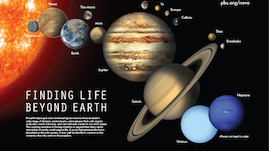Finding Life Beyond Earth
- Teacher Resource
- 5.16.12
- NOVA
Education Collections allow us to curate the most relevant online resources related to specific NOVA programs. Use this collection of resources as a source of inspiration for your classroom: find a video clip to start a discussion with your students, incorporate an activity or demonstration into your class, or get some ideas about how these resources can be strung together with our example lesson plan.
This education collection consists of an activity guide with seven hands-on activities and accompanying video excerpts from NOVA's "Finding Life Beyond Earth" program. The activities and videos explore questions at the heart of the search for extraterrestrial life, such as "What is life?" and "Where do we find habitable conditions?" The resources enable educators to engage audiences with this program's subject and encourage a better understanding of the existence of life in our solar system.
Documents
-

-

Activity Collection
Document (PDF)
Use these seven hands-on activities to explore questions at the heart of the search for extraterrestrial life. Each activity is accompanied by a video excerpt from NOVA's "Finding Life Beyond Earth" program.
Video Clips
-

How the Inner Solar System Formed
Video Clip | 3:53
Learn how the rocky planets of the inner solar system formed from a cloud of gas and dust more than 4.5 billion years ago.
-

Life's Basic Ingredients
Video Clip | 2:40
Learn what astrobiologists consider to be the three basic ingredients of life—water, organic compounds, and energy.
-

Comets Bombard the Early Earth
Video Clip | 4:45
Learn how comets carrying chemicals necessary for life could have made their way to Earth.
-

Life's Extreme Environments
Video Clip | 1:50
Meet microbes that thrive in a wide variety of harsh conditions, such as dry deserts, toxin-laden lakes, dark caves, and acidic rivers.
-

Microbial Life in Antarctica
Video Clip | 1:11
Watch as scientists working in the dry valleys of the Antarctic drill into the Mars-like soil and ice, where they discover microorganisms.
-

Thriving on the Arctic Seafloor
Video Clip | 2:28
Explore the deep Arctic Ocean, which may be similar to the ocean on one of Jupiter's moons called Europa.
-

Life on Enceladus?
Video Clip | 4:57
Follow NASA's Cassini mission to Saturn and the surprising discoveries it has made about Enceladus, one of Saturn's 62 moons.
-

Life on Europa?
Video Clip | 3:02
Learn about Jupiter's moon Europa. Images reveal a surface covered with jagged areas of ice in a pattern similar to the one made by sea ice on Earth.
-

Life on Mars?
Video Clip | 2:59
Learn about the discovery of water ice on Mars. Satellites reveal that if all the water ice melted, it would cover the entire planet in an ocean more than 80 feet deep.
-

Life on Titan?
Video Clip | 3:00
Learn about Titan, the largest moon of Saturn. Through radar imaging, scientists discover that Titan's surface is covered with liquid methane and ethane.
-

Life Beyond the Solar System
Video Clip | 2:35
Learn how the Hubble Space Telescope is being used to find dense disks of dust and gas particles forming around new stars like our Sun.
-

Planet-Hunting
Video Clip | 4:34
Learn how scientists search for planets beyond our solar system by observing a slight dimming of starlight when a planet passes in front of its star.
Lesson Plan
Use this lesson plan in your classroom - or as inspiration for creating your own "Finding Life Beyond Earth" lesson plan.
-
STEP1

Activity 4: Extreme Living
Document (PDF)
Use activity four, "Extreme Living", in the activity collection to demonstrate that life could exist beyond Earth based on the idea that Earth has organisms that live in conditions comparable to ones found elsewhere in the solar system. Students will match a microbe to an extreme environment in which it could live using cards that show extremophiles and some of Earth's extreme environments. Then use the related video excerpts, along with the provided discussion questions, to visit some extreme environments on Earth and join in the search for life -
STEP2

Watch "Life's Extreme Environments"
Video Clip | 1:50
Meet organisms that thrive in a wide variety of harsh conditions, such as dry deserts, toxin-laden lakes, dark caves, and acidic rivers. These microbes—dubbed extremophiles—show life's adaptiveness and are broadening scientist's understanding of the diverse environmental conditions life can withstand. Since similar conditions have been detected or inferred on other planets or moons, it is possible that microbes might live there as well. -
STEP3

Watch "Microbial Life in Antarctica"
Video Clip | 1:11
What can one of the most extreme deserts on Earth—the dry valleys of the Antarctic—tell us about life on Mars? Watch as scientists drill into the Mars-like soil and ice, where they discover microorganisms in a film of liquid water at the point where the dirt meets the ice. -
STEP4

Watch "Thriving on the Arctic Seafloor"
Video Clip | 2:28
Follow biologist Tim Shank as he explores the deep Arctic Ocean, which may be similar to the ocean on Europa. Robots sent to the ocean floor discover a hostile environment that is home to new forms of life that use sulfur, hydrogen, and methane as chemical sources of energy.






